The bog garden / swamp garden
In most gardens there is usually an awkward spot where not much will flourish. Often this is a problem caused by nearby trees. The trees suck out all the moisture from the ground before your temporary tropical plants have any chance of establishing. Amending the soil and increasing irrigation levels seems only to favour the trees. One solution of course is to plant drought tolerant plants. However many drought tolerant plants such as yuccas come in the form of a spiky rosette. This results in the plants filling up with leaves from the offending trees and subsequently filling your hands/arms/face full of holes as you attempt to rid the spikes of leaves. An alternative solution is to create a bog garden or swamp. Your chosen plants can now enjoy an exclusive reservoir of water.
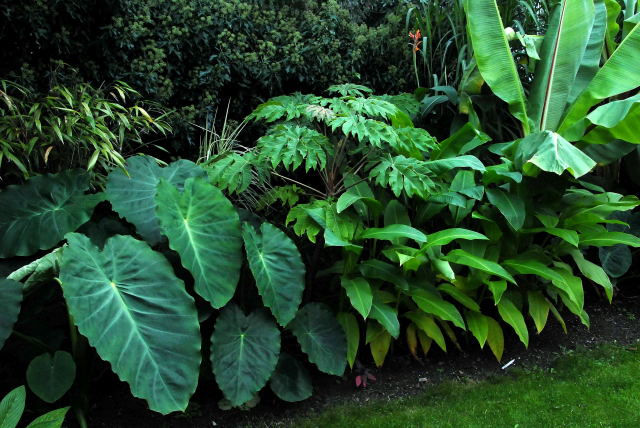
In the picture shown above, the area between the Tetrapanax (in the centre of the shot) and the left of photo is surrounded by an increasingly large Eucalyptus, an old apple tree and a substantial ivy. Out of shot to the left a group of phormiums and eryngium agavifolium are able to hold their ground.
Over the years as the eucalyptus has grown, getting any feel of luxuriance at this end of the garden became increasingly difficult. Any thing planted in this area would struggle to reach anything like the proportions of their cloned brethren planted two or three meters away. When this border was viewed from the other end, the area below the trees would just fizzle out. The solution was to create a small section of bog garden to maintain the visual flow from one end of the border to the other.
Building the bog garden
You will need the following:- A tarpaulin
- A pond liner
- A spade
- Some manure
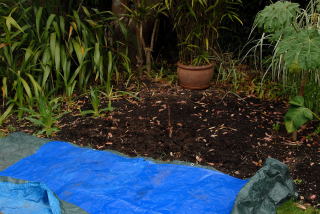
- First of all a tarpaulin is placed along side the section of the border to be dug. This prevents the grass or whatever is adjacent to the soil from becoming too messy. It also makes gathering up the last of the soil at the end of the process a lot easier.
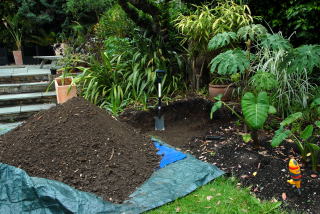
- Mark out the area and dig the hole to a depth of a spade and a half or so.
- Pile the soil onto the tarpaulin removing any perennial weeds and bits of root along the way.
- In this instance the soil had previously been improved. If the soil is of poor quality follow the advice here on soil improvement.
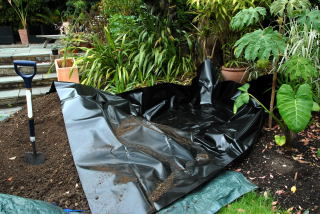
- Lay a pond liner over the hole, as central as possible.
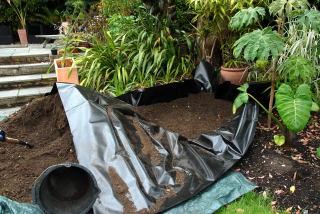
- Back fill the hole adding manure or home made compost as you go.
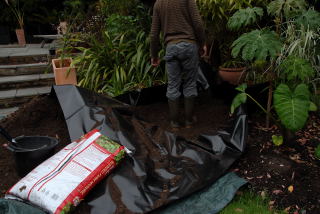
- Every now and then, gently trample the soil to make sure that it all goes back into the bog garden.
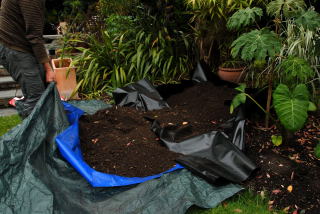
- Once the majority of soil has been shovelled back, the remaining soil can be coaxed into the hole by lifting the tarpaulin.
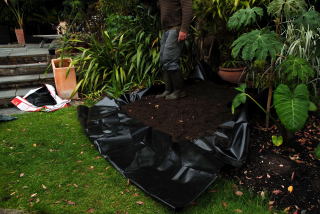
- Give the soil a final trample.
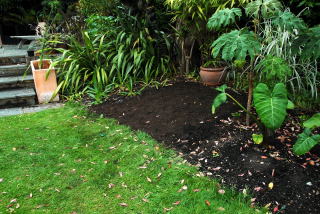
- Trim off the excess pond liner and the bog garden is ready for planting.
Plants for the bog garden
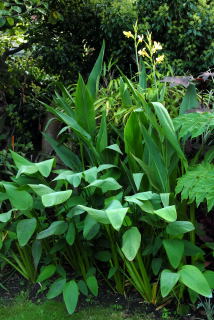 There are two options here:
There are two options here:
- Use tropical water-loving plants.
- Use hardy bog plants.
Using tropical water-loving plants will require an annual planting of the bog garden. Anything remotely tender is unlikely to survive in the ground over the winter if the soil is wet and freezes.
Hardy Bog plants on the other hand can be left out permanently. There are pluses and minuses about using hardy bog plants. On the positive side, less time is required for digging up and re-planting. There are also many hardy bog plants with an exotic appearance. On the negative side the hardy plants tend to be perrenial and as such will begin to die back towards the end summer. This could leave your display with a prematurely yellowing patch nestled amongst your tropical plants who will be at the peak of their luxuriance.
The picture to the right shows Canna glauca and Thalia geniculata growing in the bog-garden end of the border in a previous year.

